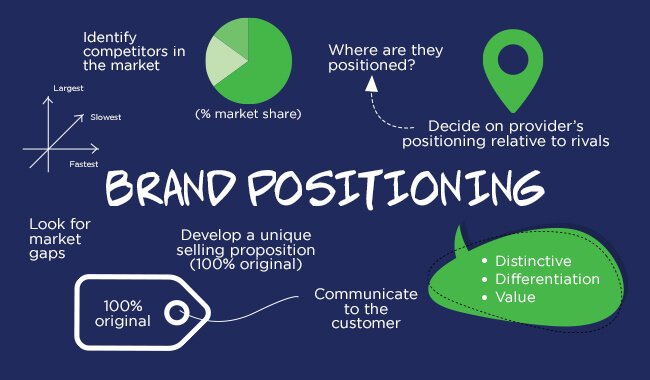Daniel Davidson, MD, MBA, DBA, PHD
Introduction:
A solid brand identity and positioning are necessary for success. Finding the right branding and market placement, nevertheless, in comparison to your rivals, can be difficult. Finding your own niche involves careful consideration, strategic planning, and creative insight because competitors are fighting for market share and customer attention. This article goes into the intricate details of market positioning and how to successfully set your business apart from the competition.
Know Your Competitors:
Success in any business project depends on having a thorough understanding of your rivals. It entails carrying out in-depth investigation and examination to get knowledge about your rivals’ identities, products, and business practices. Understanding your rivals can help you recognize their advantages and disadvantages, evaluate their approaches and market positioning, and spot possibilities and dangers in the competitive environment. With this information, you can effectively define your brand, make well-informed decisions, and outperform the competition.
Define Your Unique Value Proposition:
The distinctive promise or idea that distinguishes your brand from rivals and conveys the special advantages or value you provide to your target market is known as your unique value proposition, or UVP. It captures the essence of what sets your brand apart and explains to consumers why they should pick your goods or services over competing ones.
In order to satisfy the demands, pain issues, or desires of your clients, your brand must specifically mention these benefits or solutions in your explanation of your UVP. The salient characteristics, benefits, or results that set your brand apart from the competition and appeal to your target market should be emphasized in this explanation.
For your clients, your UVP should respond to the following inquiries:
What can you provide? Clearly state what goods or services you offer and how they help your clients meet their needs or solve problems.
What makes it special? Determine what makes your brand stand out from that of your competitors, be it cutting-edge features, excellent craftsmanship, outstanding customer service, or a distinctive selling proposition.
What advantages exist? Emphasize the particular advantages or benefits that consumers can anticipate from selecting your brand, such as financial savings, ease of use, dependability, effectiveness, or emotional fulfillment.
How does it address my issue? Describe how your brand responds to the problems, difficulties, or goals of your customers and how it produces measurable benefits or results that enhance their lives or enterprises.
Why should I pick you? Provide customers with strong reasons to select your brand above competitors by highlighting the special value proposition that speaks to their priorities, requirements, and preferences.
Understand Your Target Audience:
Acquiring a thorough understanding of your target audience entails learning a great deal about the people or demographics who are most likely to be interested in your offerings. This knowledge extends beyond simple demographics such as age, gender, and place of residence, exploring psychographics, behaviors, and motivations.
Attitudes, values, beliefs, hobbies, and lifestyle decisions are all included in the category of psychographics. You may adjust your marketing messaging, product offerings, and brand positioning to appeal to the interests and goals of your target audience by being aware of these characteristics of that group.
Understanding how your target market engages with your brand, goods, and rivals is the main goal of behavioral insights. This covers their brand loyalty, internet activity, purchase patterns, and reactions to marketing cues. You can find patterns and trends that guide your marketing strategy and approaches by examining these habits.
Conduct a SWOT Analysis:
A SWOT analysis is a method for strategic planning that evaluates an organizations or business’s external opportunities and threats in addition to its internal strengths and weaknesses. The following explains each element of a SWOT analysis:
Advantages:
Strengths are the inherent qualities and assets that provide a company with a competitive edge or help it succeed. These may consist of elements like:
Distinctive goods or services
Strong reputation of the brand
Skilled and knowledgeable staff
Effective procedures and activities
Intellectual property or proprietary technology access
Robust resource or financial performance
A well-established market or engaged audience
Weaknesses:
Weaknesses are internal elements that make the company less competitive than competitors in the market. These could consist of insufficient infrastructure, antiquated technology, low brand recognition, resource constraints, or ineffective procedures. In order to address areas for improvement and minimize vulnerabilities that could jeopardize the success of the business, it is imperative to identify weaknesses.
Opportunities:
These are outside variables or market trends that have the potential to have a favorable effect on the company. These could include new product developments, shifting consumer preferences, technology breakthroughs, market expansion, or joint ventures with like-minded companies. A company can take advantage of favorable market conditions and pursue growth and expansion initiatives by identifying opportunities.
Threats: External elements or difficulties that can jeopardize the performance or sustainability of the company are considered threats. These could include consumer demand alterations, government regulation changes, economic downturns, rival firm competition, and disruptive technologies. An organization can create plans to reduce risks and protect against any negative effects by identifying threats.
Develop a Compelling Brand Story:
Creating a narrative that expresses the core of your brand and connects with your audience on an emotional level is essential to creating a compelling brand story. It reaches deeper into your brand’s essence and establishes a stronger connection with customers than just enumerating features or advantages. A strong brand narrative unites your company’s values, purpose, vision, and personality into a coherent story that enthralls and involves your target audience.
It distinguishes you from rivals by emphasizing what makes you special and captivating and humanizes your brand, making it memorable and relatable. In the end, a strong brand narrative encourages fidelity, establishes credibility, and creates deep bonds with your target audience—all of which contribute to the long-term prosperity and expansion of your company.
Continuously Monitor and Adapt:
In the context of branding and market positioning, constant observation and adjustment entails being alert to shifts in the competitive environment, customer preferences, and industry trends. It’s important to keep your brand strategy dynamic instead than taking a “set it and forget it” approach.
Monitoring means keeping a careful watch on a number of variables that could affect how your brand is positioned, including changes in customer behavior, new market trends, rival strategies, and technological improvements. This entails compiling information, evaluating market research, monitoring social media discussions, and keeping up with news and insights from the industry.
On the other hand, adapting is taking proactive measures to address the information obtained via activity monitoring. It entails being prepared to modify your positioning and branding plans in response to fresh data or evolving conditions. To better meet customer tastes and market expectations, you might want to consider refining your messaging, making adjustments to your product offers, modifying your target demographic, or reorienting your marketing strategies.
Conclusion:
A combination of strategic analysis, creativity, and customer-centricity is needed to ascertain the best branding and market positioning in comparison to your competitors. You can effectively differentiate your brand and establish a unique position in the market by knowing your competitors, defining your unique value proposition, knowing your target audience, doing a SWOT analysis, creating a compelling brand story, and continuously monitoring and adapting.







